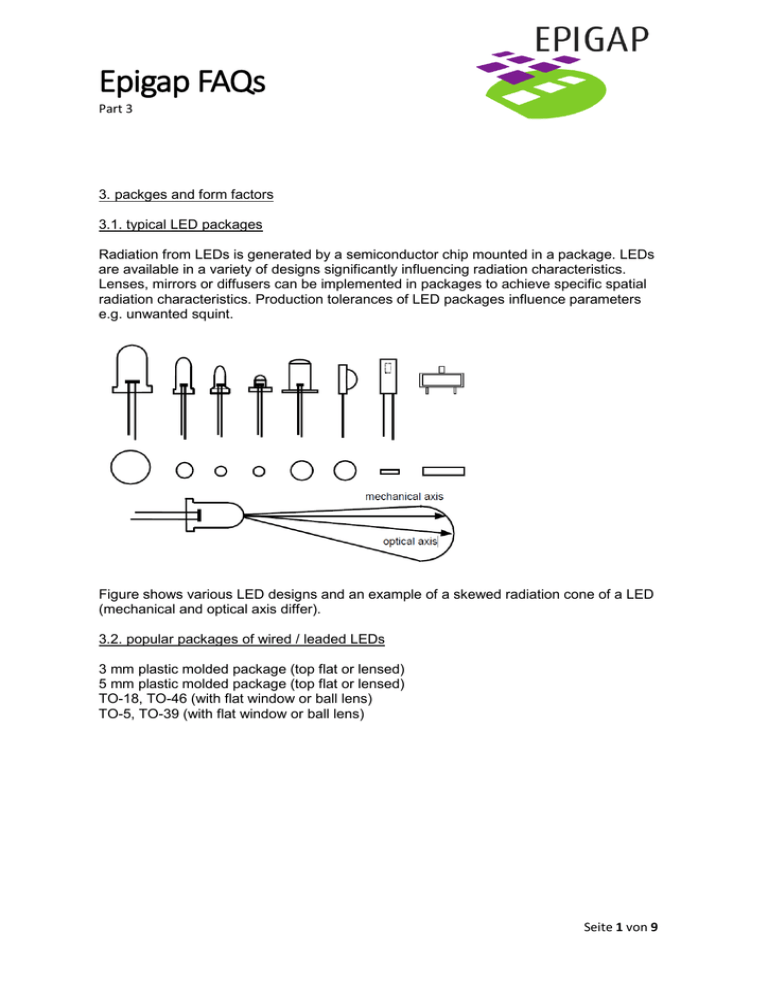Epigap FAQs - EPIGAP Optronic GmbH
advertisement

Epigap FAQs Part 3 3. packges and form factors 3.1. typical LED packages Radiation from LEDs is generated by a semiconductor chip mounted in a package. LEDs are available in a variety of designs significantly influencing radiation characteristics. Lenses, mirrors or diffusers can be implemented in packages to achieve specific spatial radiation characteristics. Production tolerances of LED packages influence parameters e.g. unwanted squint. Figure shows various LED designs and an example of a skewed radiation cone of a LED (mechanical and optical axis differ). 3.2. popular packages of wired / leaded LEDs 3 mm plastic molded package (top flat or lensed) 5 mm plastic molded package (top flat or lensed) TO-18, TO-46 (with flat window or ball lens) TO-5, TO-39 (with flat window or ball lens) Seite 1 von 9 Epigap FAQs Part 3 3.3. "stand-off" or "stopper" Some leaded LEDs and PDs feature a "stand-off" option (shown below at right side) to control the position of the component when inserted into a PCB for soldering. Figure. LED without und with stand-off. Seite 2 von 9 Epigap FAQs Part 3 3.4. TO packaging In electronics TO-18 is a designation for a style of transistor metal case. The case is more expensive than the similarly sized 5 mm plastic package. There are TO-18 packages with two and three pins. Versions with flat window, lens and / or parabolic reflectors are available. Examples shown below: LED in a TO-18 package with glass lens, viewing angle ±6 degrees (12°). LED in a TO-18 package with epoxy lens, viewing angle ±60 degrees (120°). Seite 3 von 9 Epigap FAQs Part 3 Au- and Ni-plating are widely used to protect devices operating in demanding environments. Main advantages of TO packages are reliability and high accuracy of manufacturing. 3.5. surface-mount devices (SMD) Surface-mount technology (SMT) is a popular method for producing electronic circuits in which the components are mounted or placed directly onto the surface of printed circuit boards (PCBs). An electronic device so made is called a surface-mount device (SMD). It is generally low profile component. In the industry it has largely replaced the throughhole technology construction method of fitting components with wire leads into holes in the circuit board. SMD components are usually smaller than its through-hole counterpart because it has either smaller leads or no leads at all (leadless components). It may have leads of various styles, flat contacts, a matrix of solder balls (BGAs) or terminations on the body of the component. Seite 4 von 9 Epigap FAQs Part 3 flat 1206 SMD-component: lensed 1206 SMD-component: high-power 3838 SMD-component: 3.5.1. sizes of SMD LEDs Metric code becomes more popular though imperial code (inch) is still used. Seite 5 von 9 Epigap FAQs Part 3 3.5.2. typical SMD form factors from EPIGAP Circuit substrate: AI2O3 or AlN ceramics. With flat, lens or resin dome top, silicone encapsulation. Lead free solderable, soldering pads are gold plated. Built-in ESD protection device (Zener diode) for most GaN-based LEDs. Metric code 1608 1912 2012 2520 3018 3020 3216 3522 3527 3628 3838 5050 Imperial (inch) code 0603 0805 0805 1008 1208 1208 1206 1409 1411 1411 1515 2020 7090 2835 Size L x W x H, mm 1.9 x 1.2 x 1.2 2.0 x 1.25 x 1.1 2.5 x 2.0 x 1.0 3.0 x 1.8 x 1.0 3.0 x 2.0 x 1.0 3.2 x 1.6 x 1.2 3.5 x 2.2 x 1.24 3.5 x 2.7 x 1.8 3.6 x 2.8 x 1.9 3.8 x 3.8 x 0.9 5.0 x 5.0 x 0.9 5.0 x 5.0 x 2.1 7.0 x 9.0 x 4.4 Usually SMD cases are white but for some application black SMD cases are preferred to avoid unwanted reflection. SMD LEDs are often taped in 8 mm, 12 mm, 16 mm, 24 mm or larger blister tape. 3.5.3. What are advantages and disadvantages of SMD LEDs? 3.5.3.1. Advantages Main advantages of SMT over the older through-hole technique are: - simpler and faster automated assembly. Some placement machines are capable of placing more than 136,000 components per hour. - small low-profile components (as of 2012 smallest SMD-type was 01005 with 0.4 × 0.2 mm² ; appearing 2013: SMD 03015 with only 0.3 × 0.15 mm²) - much higher component density feasible and more connections per component - lower initial cost and set up time for mounting SMDs onto PCB compared to leaded components - fewer holes need to be drilled - Small errors in component placement are corrected automatically as the surface tension of molten solder pulls components into alignment with solder pads. - components can be placed on both sides of the circuit board. - lower resistance and inductance at the connection; consequently, fewer unwanted RF signal effects and better and more predictable high-frequency performance. - better mechanical performance under shake and vibration conditions - many SMT parts cost less than equivalent through-hole parts. - better EMC performance (lower radiated emissions) due to the smaller radiation loop area (because of the smaller package) and the smaller lead inductance. Seite 6 von 9 Epigap FAQs Part 3 3.5.3.2. disadvantages - manual prototype assembly and component-level repair are difficult - SMDs cannot be used directly with plug-in breadboards (a quick snap-and-play prototyping tool) - As solder joint dimensions in SMT are getting smaller reliability of these solder joints may become a concern. - SMT is unsuitable for large, high-power or high-voltage components. If necessary it is feasible to combine SMT and through-hole components (transformers, heat-sinked power semiconductors, physically large capacitors, fuses, connectors etc.) on one PCB. - SMT is unsuitable for components that are subject to mechanical stress such as connectors. 3.6. topologies / geometries of LED chips There are various topologies of LED chips. Usually a drawing of the chip is part of a LED chip data sheet. Sizes of common rectangular LED chips range from 200µm to 1mm. Chip thickness is about 100µm. Usually there is one electrode at the top, the other on bottom of the chip. Chips have different polarities p-up (anode on top) or n-up (cathode on top). There are chips with both electrodes on top. Some topologies are shown here: 3.6.1. Epigap-EOLC-550-10. Simple contact form for low-current GaP LED chip: Seite 7 von 9 Epigap FAQs Part 3 3.6.2. contact geometry of medium-power Epigap chip EOLC-850-25-1: 3.6.3. contact geometry of a power chip Epigap EOLC-870-11 3.6.4. LED on GaN basis grown on transparent sapphire substrates have both contacts at the top of the chip. 3.6.5. Epigap EOLC-525-31: complex contact form and additional contact pads for better current distribution for high power Seite 8 von 9 Epigap FAQs Part 3 3.6.6. Epigap EOLC-455-34 rectangular LED chip. Seite 9 von 9
